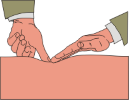
Translated from Spanish automatically
Response on the range of times to be used in IT / AT curves
Question
"
When drawing IT - AT curves I find different indications of how to do them and the most appropriate range of steps (or jumps) between times. Whether to do them upward or downward, etc. I would like your opinion and experience on the following:
Is it better to go up or down?
What range of steps in the times is best?
At what time do the curves start?
"Answer
Glad to answer.
I / T / A / T curves serve many things, they can be done in different ways and focus on certain sections. Shortcuts have already been described, which unfortunately have become so popular that it seems that by making these shortcuts the complete curves have already been drawn; forgetting the essence and the most important information for physiotherapists. I am referring to the rheobase, the chronaxy and the accommodation quotient; which are the shortcuts that were extended to find out whether or not a patient suffered from peripheral paralysis.
-- About ascending or descending. It depends on what you look at, if we talk about times, moving from higher to lower would be downward, but if you look at the intensity, as the times decrease, the trend of the intensities is to be higher and higher. That is, when with low times, the intensities go up.
But I think you mean the leaps in time, and I'm going to continue this way.
Normal curves are better done in a descending direction in times (except for some circumstances that I will detail). If you do them in a descending direction, the normal thing is that the patient asks you for more intensity when making the change, and not the other way around, who could get an unpleasant surprise and urge you to lower the intensity.
When can and should the reverse be done?
- To find the triangle of therapeutic utility (TUT)
- In the ascending zone of the A / T curve in long times
- At the longest times of the I / T and A / T curves
- To find the time of cronaxia
- To reaffirm and repeat traces at very specific points, such as useful points or the angle of deflection (making several backward and forward strokes).
As you can see, you really have to combine the two options. I recommend that you reread chapter 10 of my book in detail Electroterapia en fisioterapia 3ª edition to delve into the subject.
-- About the jump range. It also depends a lot on the circumstances of the test and the patient.--
Faced with a patient with significant peripheral paralysis, the quadrangular should be done starting at 500 ms, 200 ms, 100 ms, 50 ms and it will surely be enough to see its severity. In the event that no response appears in 500 ms, it is tested in 1000 ms and can occur in the event that no response appears either; so that if this were so, the patient has already suffered from complete walerian degeneration.
In this same case of severe paralysis, the triangular or A / T should also be done, if only to see how it is related to the quadrangular and to know where the TUT begins, in order to know where to start with the treatment. This tracing should be done from short times to long times, starting for example, in 50 ms (before crossing with the A / T of the healthy ones).
Before an athlete whose best current is intended to be designed for stimulation. The I / T curve can start in 50 ms and go down in short steps to draw well the features of the curves, such as useful points (even repeat those areas with the highest possible definition).
The triangular can also be done starting at 100 ms and descending with short jumps in the area of the angle of deflection, because two can appear, or one with a step. In the short times of this curve the jumps can be long. I refer you again to book in Chapter 10 and look at the deflection angle variants.
Imagine that you pretend to know the accommodation quotient. Exploring the response in 1000 ms with square and triangular pulses, you already have the intensity values to make the division and find the quotient or accommodation index.
Can rheobase be achieved with values of times other than 1000 ms? In the quadrangular, yes (if they coincide with the result of 1000 ms) but in the triangular, the values of 1000 ms are necessary.
Imagine a treatment follow-up in which you pretend to know variations in an area to adjust parameters. In that case you adjust the times that affect the area, the range of jumps of very short times, and to draw with precision the section of the curve of the area that interests you with the highest possible definition; even repeating already found values.
-- On the value of the time at which the curves start, Your question is already partly answered with the previous cases, because in reality the complete curves are usually made the first time, or to make reports and present them.
In practice, after the first study with the complete route, evolutions of the accidents of interest are made, such as the useful points, the angle of deflection, if the intensity rises or falls, etc. And also, we must not forget the "mental" records, I mean: if you know where the TUT began yesterday, it is good that when applying today's treatment, take a moment to see if it has moved, remember the data and repeat tomorrow. Only a few seconds are lost before starting treatment.
In practice with students (people with normal sensitivity) I recommend starting the quadrangular with times of 100 ms, moving towards short times until finishing it (without lowering the intensity to zero at each time step). To finish it on the right up to 1000 ms, the times are promoted and the model or patient is asked to "endure the discomfort".
In the triangular one you can also start for 100 ms, advance until short times until finishing on the left. In the first steps, the intensity will have to be reduced and then it is maintained and readjusted without going down to zero. It ends on the right, moving towards long times and asking the model or patient to concentrate and endure the discomfort.
In this triangular response zone, the difficulty is for the physiotherapist to discriminate well the appropriate response and not to confuse it with the patient's defense responses.
A final recommendation: I suggest that before starting the test, you adjust some square pulses with times of about 20 to 50 ms and apply them to study the response, in case the electrodes have to be repositioned, so that the patient adapts to the pulses and to establish the threshold reference level of the test. After a few "cramps" beforehand, the scan can begin.
I hope I have clarified your doubts.
Publicado el 04/02/2021







